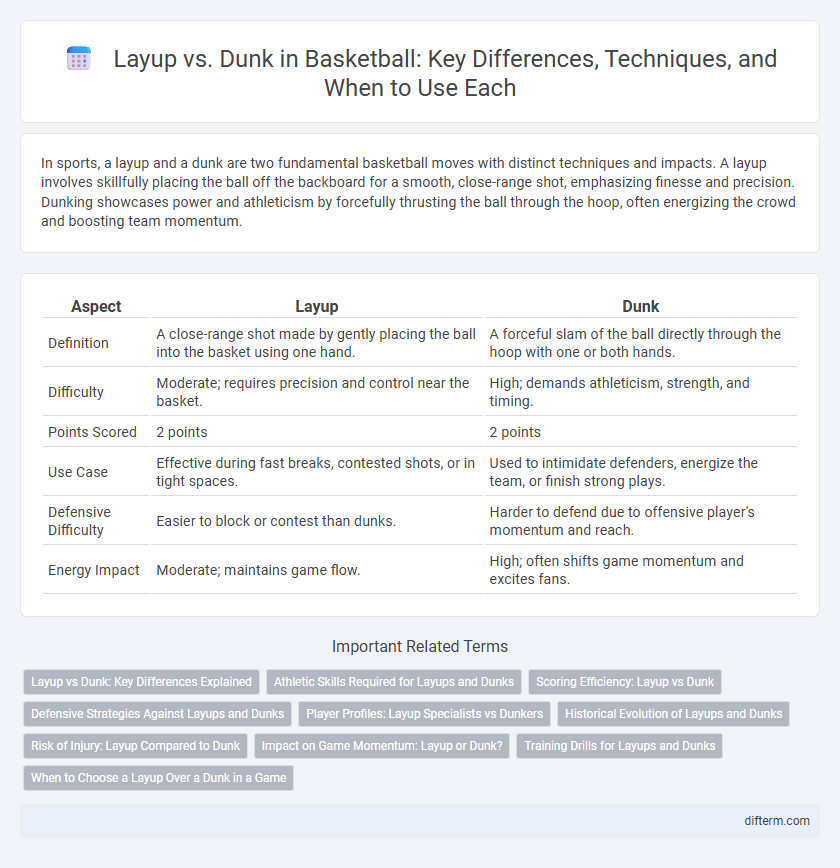In sports, a layup and a dunk are two fundamental basketball moves with distinct techniques and impacts. A layup involves skillfully placing the ball off the backboard for a smooth, close-range shot, emphasizing finesse and precision. Dunking showcases power and athleticism by forcefully thrusting the ball through the hoop, often energizing the crowd and boosting team momentum.
Table of Comparison
| Aspect | Layup | Dunk |
|---|---|---|
| Definition | A close-range shot made by gently placing the ball into the basket using one hand. | A forceful slam of the ball directly through the hoop with one or both hands. |
| Difficulty | Moderate; requires precision and control near the basket. | High; demands athleticism, strength, and timing. |
| Points Scored | 2 points | 2 points |
| Use Case | Effective during fast breaks, contested shots, or in tight spaces. | Used to intimidate defenders, energize the team, or finish strong plays. |
| Defensive Difficulty | Easier to block or contest than dunks. | Harder to defend due to offensive player's momentum and reach. |
| Energy Impact | Moderate; maintains game flow. | High; often shifts game momentum and excites fans. |
Layup vs Dunk: Key Differences Explained
Layups and dunks are fundamental basketball scoring techniques with distinct mechanics and impact. A layup involves gently placing the ball off the backboard close to the basket, emphasizing finesse and precision, while a dunk requires forcefully slamming the ball through the hoop with one or both hands, showcasing power and athleticism. The choice between a layup and a dunk often depends on a player's position, skill set, and in-game situation, with layups offering higher success rates under defensive pressure and dunks energizing teams and crowds.
Athletic Skills Required for Layups and Dunks
Layups demand precise hand-eye coordination, agility, and controlled body movement to maneuver around defenders and finish close to the basket. Dunks require explosive vertical leap, upper body strength, and timing to powerfully elevate and slam the ball through the hoop. Both skills engage core athletic abilities but differ in strength, endurance, and spatial awareness needed for successful execution.
Scoring Efficiency: Layup vs Dunk
Layups and dunks both yield high scoring efficiency, with dunks boasting nearly a 100% success rate due to their forceful, uncontestable nature. Layups, while slightly less efficient with success rates around 60-70%, offer more versatility in positioning and can be executed in tighter spaces. Players choose between layups and dunks based on defensive pressure, proximity to the basket, and tactical opportunities to maximize scoring chances.
Defensive Strategies Against Layups and Dunks
Defensive strategies against layups prioritize positioning defenders between the shooter and the basket, using verticality to contest shots without fouling. Defending dunks requires quick rotations and help defense to block or alter powerful attempts at the rim, often involving shot-block specialists. Effective rim protection blends anticipation, timing, and physicality to disrupt high-percentage layups and dunks.
Player Profiles: Layup Specialists vs Dunkers
Layup specialists, often point guards and small forwards, excel in agility, ball control, and precision close to the basket, prioritizing finesse and quick releases over raw power. Dunkers, typically power forwards and centers, leverage their height, vertical leap, and strength to dominate inside, using slam dunks to energize teammates and intimidate opponents. Player profiles reveal that layup specialists contribute consistently through high-percentage shots and playmaking, while dunkers impact scoring through explosive, high-impact finishes.
Historical Evolution of Layups and Dunks
Layups and dunks have evolved significantly since basketball's inception in 1891, with layups initially dominating as the primary close-range scoring method due to their simplicity and effectiveness. The dunk emerged prominently in the 1960s, popularized by players like Julius Erving and later Michael Jordan, transforming the game by adding athleticism and crowd appeal. Advances in player skill, training, and rule changes facilitated the dunk's rise as a high-impact scoring technique, while layups remain fundamental for their versatility and consistency.
Risk of Injury: Layup Compared to Dunk
Layups generally carry a lower risk of injury compared to dunks due to their controlled execution and reduced impact on joints. Dunking involves significant force and body elevation, increasing the likelihood of injuries such as sprains, strains, or collisions with the rim or backboard. Basketball players often prefer layups during high-pressure moments to minimize physical risks while maintaining scoring opportunities.
Impact on Game Momentum: Layup or Dunk?
A dunk electrifies the crowd and often shifts game momentum instantly by boosting team confidence and intimidating opponents. Layups, while more common and consistent, provide steady scoring without dramatically altering the game's energy. Coaches rely on dunks to create momentum swings, but layups maintain offensive rhythm and control throughout the game.
Training Drills for Layups and Dunks
Effective training drills for layups emphasize footwork, hand-eye coordination, and finishing with both hands under pressure, including cone drills and reverse layup practice. Dunk training drills focus on explosive leg strength, vertical jump development, and timing, using plyometric exercises, rim grabs, and approach sprints. Combining targeted drills for layups and dunks improves overall scoring versatility and in-game finishing ability.
When to Choose a Layup Over a Dunk in a Game
Choosing a layup over a dunk in basketball depends on positioning, timing, and defensive pressure; layups are preferred when approaching the basket with tight coverage or when a dunk attempt risks a block or foul. Layups offer more control and higher success rates in fast-breaking situations or crowded paint areas. Players prioritize a layup when securing points efficiently outweighs the need for the momentum or highlight play a dunk might provide.
layup vs dunk Infographic

 difterm.com
difterm.com